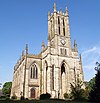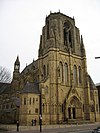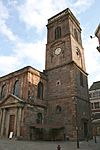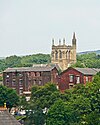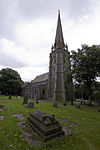Joseph Stretch Crowther was an English architect who practised in Manchester. His buildings are mainly located in Manchester, Cheshire and Cumbria.

There are 48 Grade I listed buildings in Greater Manchester, England. In the United Kingdom, the term listed building refers to a building or other structure officially designated as being of special architectural, historical or cultural significance; Grade I structures are those considered to be "buildings of exceptional interest". In England, the authority for listing under the Planning Act 1990 rests with Historic England, a non-departmental public body sponsored by the Department for Culture, Media and Sport.
Prestwich is a town in the Metropolitan Borough of Bury, Greater Manchester, England, and includes the village of Simister and the surrounding countryside. It is unparished, and contains 48 listed buildings that are recorded in the National Heritage List for England. Of these, one is listed at Grade I, the highest of the three grades, one is at Grade II*, the middle grade, and the others are at Grade II, the lowest grade. The town is largely residential, and its most important building is St Mary's Church. The church and numerous associated structures, particularly tombs and monuments in the churchyard, are listed. The other listed buildings include houses and associated structures, other churches, a public house, structures associated with the Thirlmere to Manchester water supply, a boundary stone, and two war memorials.
Shaw and Crompton is a civil parish in the Metropolitan Borough of Oldham, Greater Manchester, England. It contains 19 listed buildings that are recorded in the National Heritage List for England. Of these, one is listed at Grade II*, the middle grade, and the others are at Grade II, the lowest grade. The parish contains the town of Shaw and Crompton and the surrounding countryside. Most of the listed buildings are farmhouses, farm buildings, houses and cottages, many of them dating from the late 18th century. The other listed buildings include an ancient cross shaft, churches, a lych gate, and a war memorial.
Chadderton is a town in the Metropolitan Borough of Oldham, Greater Manchester, England and it is unparished. It contains 19 listed buildings that are recorded in the National Heritage List for England. Of these, one is listed at Grade II*, the middle grade, and the others are at Grade II, the lowest grade. The area was rural until the coming of the Industrial Revolution, silk weaving arrived in the 18th century, and in the 19th and 20th centuries large cotton mills were built. The Rochdale Canal runs through the town, and two structures associated with it are listed, a bridge and a lock. The oldest listed buildings are farmhouses and a country house. The later buildings reflect the growing wealth of the town, and include cotton mills, churches, civic buildings, and a war memorial.
Heywood is a town in the Metropolitan Borough of Rochdale, Greater Manchester, England, and it is unparished. The town and the surrounding countryside contain 18 listed buildings that are recorded in the National Heritage List for England. Of these, two are listed at Grade II*, the middle grade, and the others are at Grade II, the lowest grade. Until the coming of the Industrial Revolution the area was rural, and during the 19th century cotton mills were built. The earliest listed buildings are a house and a farmhouse with farm buildings. The later listed buildings include cotton mills and a chimney, churches and associated structures, a railway warehouse, a library, a house designed by Edgar Wood, and two war memorials.
Middleton is a town in the Metropolitan Borough of Rochdale, Greater Manchester, England, and it is unparished. The town and the surrounding countryside contain 45 listed buildings that are recorded in the National Heritage List for England. Of these, one is listed at Grade I, the highest of the three grades, seven are at Grade II*, the middle grade, and the others are at Grade II, the lowest grade. Until the coming of the Industrial Revolution Middleton was a village, then came the industries of silk, cotton and coal. The oldest listed buildings consist of a church and vicarage, country houses, a school, a public house, and a bridge. The Rochdale Canal passes through the area, and locks and a bridge on it are listed. The later listed buildings include more churches, houses and schools, a drinking fountain, a bank, a club, a cotton mill, a park feature, and war memorials. The architect Edgar Wood lived in the town and he, sometimes with his partner Henry Sellars, designed some of the later listed buildings.
Rochdale is a town in the Metropolitan Borough of Rochdale, Greater Manchester, England, and it is unparished. The town and the surrounding countryside contain 139 listed buildings that are recorded in the National Heritage List for England. Of these, four are listed at Grade I, the highest of the three grades, four are at Grade II*, the middle grade, and the others are at Grade II, the lowest grade.
Eccles is a town in the City of Salford Metropolitan Borough, Greater Manchester, England. The town, which includes the area of Patricroft, contains 25 listed buildings that are recorded in the National Heritage List for England. Of these, one is listed at Grade I, the highest of the three grades, three are at Grade II*, the middle grade, and the others are at Grade II, the lowest grade.
Denton is a town in Tameside, Greater Manchester, England. The town and the township of Haughton contain 18 listed buildings that are recorded in the National Heritage List for England. Of these, one is listed at Grade I, the highest of the three grades, three are at Grade II*, the middle grade, and the others are at Grade II, the lowest grade.
Urmston is a town in the Metropolitan Borough of Trafford, Greater Manchester, England. The town, together with areas of Flixton and Davyhulme, contains 19 listed buildings that are recorded in the National Heritage List for England. Of these, one is listed at Grade I, the highest of the three grades, one is at Grade II*, the middle grade, and the others are at Grade II, the lowest grade. Until the arrival of the railway in 1872–73, Urmston was a village surrounded by a rural area, and it has since become largely residential and a commuter town. The listed buildings include churches with items in the churchyard, houses and associated structures, and four war memorials.
Manchester is a city in Northwest England. The M11 postcode area of the city includes the suburb of Clayton. This postcode area contains 15 listed buildings that are recorded in the National Heritage List for England. Of these, two are listed at Grade II*, the middle of the three grades, and the others are at Grade II, the lowest grade. Most of the listed buildings in the area are associated with the Ashton Canal, which runs through it; these consists of locks, bridges, and a lock keeper's cottage. The other listed buildings are a former manor house, a bridge in the grounds of the manor house, two churches, and a school.
Manchester is a city in Northwest England. The M15 postcode area is to the southwest of the centre of the city and includes the areas of Hulme, and parts of Moss Side and Chorlton-on-Medlock. The postcode area contains 33 listed buildings that are recorded in the National Heritage List for England. Of these, two are listed at Grade II*, the middle grade of the three grades, and the others are at Grade II, the lowest grade.
Manchester is a city in Northwest England. The M9 postcode area is to the north of the city centre and includes the districts of Blackley and Harpurhey. This postcode area contains 15 listed buildings that are recorded in the National Heritage List for England. Of these, one is listed at Grade II*, the middle of the three grades, and the others are at Grade II, the lowest grade. The area is residential, and the listed buildings include houses, churches, a pillar box, a statue, a former public baths and laundry, a war memorial, and a crematorium.

